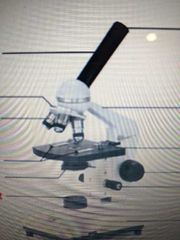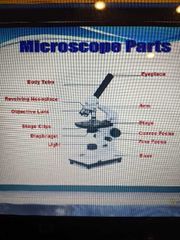![]()
![]()
![]()
Use LEFT and RIGHT arrow keys to navigate between flashcards;
Use UP and DOWN arrow keys to flip the card;
H to show hint;
A reads text to speech;
61 Cards in this Set
- Front
- Back
|
Veterinary parasitology |
The study of the parasitic relationship affecting domesticated, wild, exotic, and lab animals; the study of parasites that have the potential to be transmitted from animals to humans |
|
|
5 types of symbiotic relationships |
Predator-prey, phoresis, mutualism, commensalism, parasitism |
|
|
Phoresis |
Symbiotic relationship in which small symbiont is carried by larger |
|
|
Mutualism |
Symbiotic relationship in which both symbionts benefit |
|
|
Commensalism |
Symbiotic relationship in which one symbiont benefits and the other isn't harmed or benefitted |
|
|
Parasitism |
Symbiotic relationship in which one symbiont lives on/in the other and may cause harm. The parasite is metabolically dependent on the host |
|
|
Parasitiasis |
Type of parasitism in which the parasite is present on/in the host and may cause harm, but the host does not exhibit outward clinical signs |
|
|
Parasitosis |
Type of parasitism in which the parasite is present on/in the host and produces obvious injury or harm |
|
|
Ectoparasite |
Parasite lives on the host and causes infestation |
|
|
Endoparasite |
Parasite lives in the host and causes infection |
|
|
Parasiticides and types |
Chemical compounds (simple and complex) used to treat specific parasites. Anthelmintics, acaricides, insecticides, and antiprotozoals |
|
|
Anyhelmintics |
Parasiticides that kill roundworms, tapeworms, flukes, and thorny-headed worms |
|
|
Acaricides |
Parasiticide that kills mites and ticks |
|
|
Insecticides |
Parasiticides that kill insects |
|
|
Antiprotozoals |
Parasiticides that kill protozoan organisms |
|
|
Erratic/Aberrant Parasite |
Parasite that infects a site where it doesn't normally live |
|
|
Incidental parasite |
Parasite that is found in a host it doesn't normally live in |
|
|
Facultative Parasite |
A free-living organism that becomes parasitic in certain hosts |
|
|
Obligatory Parasite |
Parasite must live a parasitic existence to survive. Most parasites that infect domesticated and wild animals. Some have obligatory stages of life or certain sex are obligatory |
|
|
Periodic Parasite |
Parasite that doesn't have to live on/in a host, but can make frequent short visits |
|
|
Pseudoparasite |
Living creatures or objects that are mistaken to be parasitic |
|
|
Definitive host |
Harbors adult/sexual/mature stages of a parasite |
|
|
Intermediate host |
Harbors larval/juvenile/immature/asexual stages of a parasite. Transfers parasite from one definitive host to another |
|
|
Transport/Paratenic host |
Harbors a parasite in an encysted/arrested state until it is eaten by the definitive host, then the parasite wakes up and causes an infection |
|
|
Reservoir host |
Vertebrate host in which a parasite or disease occurs in nature and is a source of infection for humans and domesticated animals |
|
|
Homogenous/monoxenous Parasite |
Infects only one type of host |
|
|
Stenoxenous parasite |
Parasite with a narrow host range |
|
|
Euryxenous Parasite |
Parasite with a very broad host range |
|
|
Zoonosis |
Any disease or parasite that is transmissible from animals to humans |
|
|
Linnaean classification and added classification |
Kingdom Phylum Class Order Family Genus species. Domain added: bacteria, archaea, eukaryota |
|
|
5 Kingdoms |
Plantae, Animalia, Protista (unicellular organisms), Monera (algae), Fungi |
|
|
Which Kingdoms contain parasites of domesticated animals? |
Animalia and Protista |
|
|
Monogenetic Trematodes/Flukes |
Ectoparasites of fish, amphibians, and reptiles. Rarely mammals |
|
|
Digenetic Trematodes/Flukes |
Endoparasites of the GI tract in large and small animals, can also infect lungs and blood vasculature. Operculated eggs can be identified in the feces of domestic animals |
|
|
Eucestodes/ True Tapeworms |
Flatworms found in the GI tract of host. Eggs can be found in fecal float, larva stages occupy extraintestinal tissue of intermediate hosts (=pathology). Lack alimentary canal, absorb nutrients through tegument |
|
|
Cotyloda/ Pseudotapeworms |
Flatworms found in the GI tract of host. Adult ribbon-like, eggs can be found in fecal float, larval stages found in intermediate hosts: microscopic aquatic crustaceans and the musculature of fish & reptiles |
|
|
Nematodes/Roundworms |
Most numerous, complex, and variable helminth parasites of domesticated animals. Adults elongated, unsegmented, cylindric worm. Both adults and larva produce significant pathology, eggs can be found on a fecal float |
|
|
Acanthocephalans/Thorny-headed worms |
Found in GI tract of host, use spiny proboscis on anterior end to attach. Lack alimentary tract, absorb nutrients through tegument. Adults elongated, unsegmented, cylindric worms and eggs can be found in fecal float |
|
|
Hirudineans/Leeches |
Blood-feeding ectoparasites of wild and domestic animals. Annulated, segmented worms found in freshwater, marine, or terrestrial env. Produce significant pathology |
|
|
Arthropods |
Largest phylum in the animal kingdom, can be causal agents, intermediate hosts, vectors, or the source of toxins, venomous substances. |
|
|
Metazoan |
Multicellular organisms, animal kingdom |
|
|
Protista/Protozoans |
All unicellular organisms, most free-living but some parasitic and cause significant pathology |
|
|
What are the types of fecal collection |
Voided, direct, pooled samples |
|
|
Fecal gross exam includes |
Consistency, color, blood, mucous, adult parasites or tapeworm segments |
|
|
Hematochezia |
Stool color: fresh, bright red blood due to bleeding in the colon/rectum |
|
|
Melena |
Stool color: dark, tarry stool due to digested blood in the small intestines |
|
|
Mucous in feces and causes |
A slimy substance made by the intestines to keep the colon lubricated. Possibly caused by stress, parasites, bacterial overgrowth, dietary indiscretion, tumors |
|

|

|
|
|
Microscope eyepiece/ocular lens |
Magnifies specimen image, what you view through |
|
|
Microscope body tube |
Supports eye piece & lens, maintains proper distance from specimen |
|
|
Microscope revolving nosepiece |
Holds objective lenses, turns to change magnification |
|
|
Microscope objective lens |
Magnify image of specimen, as you increase magnification you decrease area |
|
|
Microscope stage & stage clips |
Hold slide with sample |
|
|
Microscope diaphragm |
Controls amount of light on specimen |
|
|
Microscope adjustment knobs |
Move the stage to focus, coarse= larger change fine = sharpen image |
|
|
Microscope magnification |
Ocular lens (10x) times objective lens (4x/10x/40x/100x) |
|
|
Three basic types of nematodes |
1. Free-living and residing in marine, freshwater, and soil environments 2. Plant parasites 3. Animal and human parasites |
|
|
Nematode cuticle |
Thin covering over entire body |
|
|
Nematode cervical alae |
Flattened cuticle at the anterior of the body |
|
|
Nematode copulatory bursa |
Flattened cuticle at the posterior of males to hold on to females during mating |
|
|
Nematode bursal rays |
Finger-like projections that make up the copulatory bursa |

